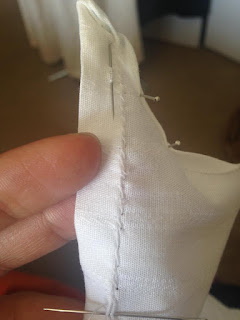The Art of the Fan: dyeing with natural pigments
Wanted to try a little experiment this week using some old Tumeric powder I had laying around in the pantry, and one of my sandalwood fans. Given that both subjects are made of natural fibers I speculated that the fan would dye very well in the natural dye bath. However upon my research when it comes to using Tumeric as a dye, the color would eventually fade after a few washes. So the question remained...how to keep the color as vibrant as I wanted once the fan was dyed, and how much of the powder to use in order to create the exact pigment I wanted?

I then drained the hot water out of the dish, and then placed the fan back inside. Wanting to make my fan as bold as possible, I just sprinkled the entire container of Turmeric powder (an expired jar from Trader Joe's circa 2017) and evenly spread it all over the fan to ensure that there would be no uneven patches. Next I refilled the dish back up with boiling hot water, and waited for another 20 minutes (stirring occasionally as the sediment from the powder is pretty heavy). I carefully flipped the fan over and repeated the same method by putting the sediment over top of the fan and spreading it evenly across.

 |
| Turmeric powder |
Normally when dying any subject, you want to first soak it in warm water. Given that this was wood and this was my first time staining wood with a food dye, I opted to just use boiling water and let it soak for a good 20 min. I also want to point out that when using Tumeric as a dye, you do not need a mordant; somehow it holds to the subject well on its own.

I then drained the hot water out of the dish, and then placed the fan back inside. Wanting to make my fan as bold as possible, I just sprinkled the entire container of Turmeric powder (an expired jar from Trader Joe's circa 2017) and evenly spread it all over the fan to ensure that there would be no uneven patches. Next I refilled the dish back up with boiling hot water, and waited for another 20 minutes (stirring occasionally as the sediment from the powder is pretty heavy). I carefully flipped the fan over and repeated the same method by putting the sediment over top of the fan and spreading it evenly across.
 |
| Getting an even tan in 73 degree weather |
Once 20 minutes were up, I drained the water and dye out and gently rinsed the fan using cold water to lock in the pigment (the same you would with yarn and natural fabrics), and then placed it outside to air dry. Thankfully it was very sunny outside with a gentle breeze allowing the fan to dry quicker. I used a heavy utility clip to clamp the fan shut and allowed it to dry some more (water is still present in the wood causing it to swell up and not be able to close all the way).

Now that the fan is completely dry, I plan to add a spray on sealant to lock in the color; this will prevent any unwanted staining of the hands or garments during the summer months or any fading to the pigment itself.
So there you have it! You can try this at home yourself using natural dyes (wine, beet juice, cranberry juice, Turmeric, Coffee, Black Walnut, Blueberry, etc.)
Until then....
So there you have it! You can try this at home yourself using natural dyes (wine, beet juice, cranberry juice, Turmeric, Coffee, Black Walnut, Blueberry, etc.)
Until then....
.jpg)


Comments
Post a Comment